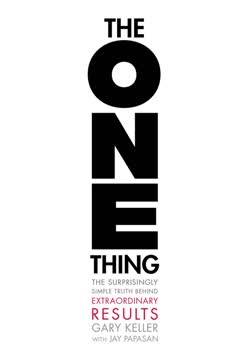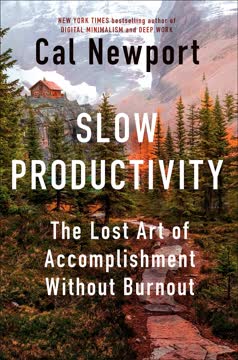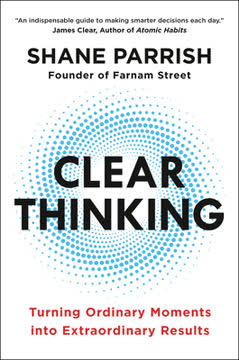Key Takeaways
1. The Dip: Embrace the Challenge for Extraordinary Success
"The Dip is the long slog between starting and mastery. A long slog that's actually a shortcut, because it gets you where you want to go faster than any other path."
The Dip is inevitable. It's the challenging period between beginning a venture and achieving mastery. This phase separates the committed from the casual, creating scarcity and value. Examples of Dips include:
- Organic chemistry for aspiring medical students
- The grind of building a startup before market acceptance
- Mastering a musical instrument or sport
Embrace the Dip as an opportunity. Those who push through often emerge as leaders in their field. The difficulty of the Dip acts as a barrier, ensuring that only the most dedicated succeed. This scarcity creates value in the marketplace.
Recognize different types of Dips:
- Manufacturing Dip: Scaling up production
- Sales Dip: Building a professional sales force
- Education Dip: Investing time in learning new skills
- Risk Dip: Taking financial risks for growth
- Relationship Dip: Building connections when it's challenging
2. Quit Strategically: Abandon Dead Ends, Persevere Through Dips
"Quitting is often a great strategy, a smart way to manage your life and your career. Sometimes, though, quitting is exactly the wrong thing to do."
Strategic quitting is crucial. It's about discerning between opportunities worth pursuing and those that lead nowhere. Quitting intelligently frees up resources for more promising ventures.
Identify and quit Cul-de-Sacs. These are situations where continued effort yields no progress or improvement. Examples include:
- Dead-end jobs with no growth potential
- Businesses in declining markets
- Relationships that show no signs of improvement
Persevere through valuable Dips. When facing a challenge that leads to a worthwhile goal, push through. The ability to distinguish between Dips and Cul-de-Sacs is a key skill for success.
3. Be the Best in Your World: Excellence Breeds Scarcity and Value
"Best as in: best for them, right now, based on what they believe and what they know. And in the world as in: their world, the world they have access to."
Define your world strategically. Your "world" can be a niche market, a specific skill set, or a particular audience. Being the best in a well-defined world creates scarcity and value.
Excellence attracts disproportionate rewards. In many fields, the top performers receive exponentially greater benefits than those who are merely good. This "winner-take-all" dynamic applies to:
- Business: Market leaders often dominate their industries
- Entertainment: Top artists command significantly higher fees
- Sports: Champion athletes receive the bulk of sponsorships and attention
Continually refine your skills. To become and remain the best, commit to ongoing improvement and adaptation to changing market demands.
4. Recognize Cul-de-Sacs: Avoid Stagnation and Mediocrity
"The Cul-de-Sac (French for "dead end") is so simple it doesn't even need a chart. It's a situation where you work and you work and you work and nothing much changes."
Identify Cul-de-Sacs early. These are situations where additional effort yields no significant improvement or progress. Recognizing them quickly can save valuable time and resources.
Common Cul-de-Sacs include:
- Businesses in saturated markets with no unique value proposition
- Careers with limited growth potential
- Relationships that have reached a stagnant state
Escape Cul-de-Sacs promptly. The opportunity cost of remaining in a Cul-de-Sac is high. Every moment spent in a dead-end situation is time not invested in potentially rewarding endeavors.
5. Short-Term Pain, Long-Term Gain: Visualize Success Beyond the Dip
"Short-term pain has more impact on most people than long-term benefits do, which is why it's so important for you to amplify the long-term benefits of not quitting."
Focus on long-term rewards. The discomfort of pushing through a Dip often overshadows the potential benefits. Actively visualize and remind yourself of the rewards awaiting on the other side.
Techniques to maintain long-term focus:
- Set clear, measurable goals
- Track progress regularly
- Celebrate small victories along the way
- Seek inspiration from those who have succeeded in similar endeavors
Use the pain as motivation. Reframe the challenges of the Dip as necessary steps toward your ultimate goal. This mindset shift can turn obstacles into opportunities for growth and differentiation.
6. Rededicate, Don't Just Persevere: Tackle Problems Aggressively
"The opposite of quitting isn't 'waiting around.' No, the opposite of quitting is rededication. The opposite of quitting is an invigorated new strategy designed to break the problem apart."
Rededication is active persistence. Instead of passively enduring the Dip, approach it with renewed energy and creativity. This proactive stance can shorten the Dip or make it more manageable.
Strategies for rededication:
- Reassess and refine your approach regularly
- Seek new perspectives and advice from mentors or experts
- Invest in skill development to tackle challenges more effectively
- Break large problems into smaller, manageable tasks
Embrace calculated risks. When facing a significant Dip, consider bold moves that could dramatically alter your trajectory. The discomfort of the Dip can be a catalyst for innovative thinking and courageous action.
7. Quitting is Not Failing: Strategic Quitting Leads to Success
"Strategic quitting is the secret of successful organizations. Reactive quitting and serial quitting are the bane of those that strive (and fail) to get what they want."
Differentiate between quitting and failing. Strategic quitting is a conscious decision based on careful evaluation. Failing occurs when you give up without considering alternatives or exhaust all resources without progress.
Benefits of strategic quitting:
- Frees up resources for more promising opportunities
- Prevents burnout and maintains motivation
- Allows for faster pivoting in response to market changes
Avoid reactive and serial quitting. Quitting impulsively due to temporary setbacks or constantly jumping between ventures without seeing them through can lead to a pattern of failure.
8. Overcome Pride: Learn When to Let Go
"Pride is the enemy of the smart quitter."
Recognize when pride hinders progress. Continuing a project or career solely to save face can be costly in terms of time, resources, and missed opportunities.
Signs that pride may be influencing decisions:
- Justifying continued effort despite clear signs of a Cul-de-Sac
- Refusing to admit mistakes or change course
- Comparing yourself to others rather than focusing on personal growth
Reframe quitting as a strength. View the ability to let go of unproductive ventures as a sign of wisdom and strategic thinking, not weakness.
9. Three Questions to Ask Before Quitting: Panic, Influence, and Progress
"The best quitters, as we've seen, are the ones who decide in advance when they're going to quit."
Question 1: Am I panicking? Avoid making quitting decisions in moments of high stress or emotion. Plan your exit strategy in advance when you can think clearly.
Question 2: Who am I trying to influence?
- Influencing individuals: Persistence has limits; know when to stop.
- Influencing markets: Requires more patience and consistent effort.
Question 3: What measurable progress am I making?
- Identify specific, quantifiable indicators of advancement.
- If there's no progress despite consistent effort, it may be time to quit.
Create a quitting framework: Establish clear criteria for when to persevere and when to quit before entering any significant venture. This approach ensures decisions are strategic rather than emotional.
Last updated:
FAQ
What's "The Dip" about?
- Author and Purpose: "The Dip" by Seth Godin is a guide to understanding when to quit and when to persevere in various aspects of life and business.
- Concept of The Dip: It introduces the concept of 'The Dip,' a temporary setback that can lead to success if navigated correctly.
- Quitting vs. Persevering: The book emphasizes strategic quitting and sticking with the right pursuits to become the best in the world.
- Target Audience: It's aimed at high-achieving, goal-oriented individuals who face obstacles and need guidance on when to push through or pivot.
Why should I read "The Dip"?
- Decision-Making Tool: It provides a framework for making informed decisions about quitting or persevering.
- Improves Focus: Helps readers focus their efforts on pursuits that have the potential for significant rewards.
- Strategic Advantage: Offers insights into gaining a competitive edge by understanding market dynamics and personal limits.
- Practical Advice: The book is concise and filled with practical advice applicable to personal and professional life.
What are the key takeaways of "The Dip"?
- Understanding The Dip: Recognize that The Dip is a natural part of any challenging endeavor and can lead to success if navigated properly.
- Strategic Quitting: Learn to quit the right things at the right time to focus resources on more promising opportunities.
- Scarcity and Value: Understand that scarcity created by The Dip increases the value of being the best in the world.
- Persistence and Success: Success often comes to those who can push through The Dip and emerge on the other side.
What is "The Dip" according to Seth Godin?
- Definition: The Dip is the long slog between starting something and mastering it, where many people give up.
- Shortcut to Success: It acts as a shortcut because it filters out those not willing to persevere, leaving more room for those who do.
- Barrier to Entry: The Dip creates a barrier that, once overcome, leads to significant rewards and market leadership.
- Strategic Importance: Recognizing and navigating The Dip is crucial for achieving extraordinary success.
How does Seth Godin define quitting in "The Dip"?
- Strategic Quitting: Quitting is not a failure but a strategic decision to stop pursuing something that isn't working.
- Avoiding Mediocrity: Quitting allows individuals to avoid mediocrity and focus on areas where they can excel.
- Resource Allocation: It frees up time and resources to invest in more promising opportunities.
- Timing Matters: The key is to quit before investing too much in a dead-end path, not during a moment of panic.
What are the different curves discussed in "The Dip"?
- The Dip: A temporary setback that, if overcome, leads to success and scarcity-driven value.
- The Cul-de-Sac: A dead-end situation where no amount of effort will lead to improvement; quitting is advised.
- The Cliff: A situation where continuing leads to a sudden drop-off or failure; recognizing it early is crucial.
- Strategic Navigation: Understanding these curves helps in making informed decisions about when to quit or persevere.
What is the significance of being "the best in the world" in "The Dip"?
- Market Rewards: Being the best in the world leads to disproportionate rewards compared to being average.
- Scarcity and Demand: Scarcity created by The Dip increases demand for those who are the best.
- Subjective Best: "Best" is subjective and defined by the consumer's needs and preferences.
- Focus and Specialization: Achieving this status requires focus, specialization, and the ability to navigate The Dip.
How does "The Dip" relate to market dynamics?
- Scarcity Creates Value: The Dip creates scarcity, which in turn increases the value of being the best.
- Market Leadership: Successfully navigating The Dip can lead to market leadership and significant competitive advantages.
- Consumer Behavior: Consumers prefer the best option available, which is why being number one is crucial.
- Strategic Positioning: Understanding market dynamics helps in positioning oneself or a product as the best in the world.
What are some practical applications of "The Dip"?
- Career Decisions: Use the concepts to decide when to quit a job or pursue a new opportunity.
- Business Strategy: Apply the principles to focus on products or services that can become market leaders.
- Personal Goals: Evaluate personal projects or hobbies to determine if they are worth pursuing through The Dip.
- Resource Management: Allocate resources effectively by quitting pursuits that are unlikely to succeed.
What are the best quotes from "The Dip" and what do they mean?
- "Winners quit all the time. They just quit the right stuff at the right time." This emphasizes the importance of strategic quitting.
- "The Dip is the reason you’re here." It highlights that overcoming challenges is essential for achieving success.
- "Average is for losers." This quote underscores the book's message that mediocrity is not a path to success.
- "If you’re not going to get to #1, you might as well quit now." It stresses the importance of focusing efforts on becoming the best.
How does "The Dip" address the fear of quitting?
- Quitting as Strategy: It reframes quitting as a strategic decision rather than a failure.
- Overcoming Pride: Encourages overcoming pride and ego to make rational decisions about quitting.
- Long-term Focus: Emphasizes the importance of focusing on long-term goals rather than short-term discomfort.
- Empowerment: Provides a sense of empowerment by encouraging readers to quit pursuits that don't align with their goals.
How can "The Dip" help in personal development?
- Self-Assessment: Encourages self-assessment to determine which pursuits are worth continuing.
- Goal Alignment: Helps align personal goals with actions by focusing on areas with the potential for success.
- Skill Mastery: Promotes the idea of mastering skills by persevering through The Dip.
- Resource Optimization: Guides individuals in optimizing their time and resources by quitting unproductive endeavors.
Review Summary
The Dip receives mixed reviews, with some praising its simple yet powerful message about strategic quitting and perseverance. Many readers find value in the concept of pushing through difficult periods to achieve success. However, critics argue the book is repetitive and oversimplifies complex decisions. Some disagree with the emphasis on being the best in a field, suggesting it neglects personal enjoyment and growth. Despite its brevity, readers generally appreciate the book's core ideas about recognizing when to quit and when to persist.
Similar Books









Download PDF
Download EPUB
.epub digital book format is ideal for reading ebooks on phones, tablets, and e-readers.













